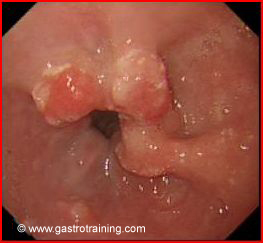Mr Jones, a 60 year old man presents with progressive dysphagia and weight loss of 1 stone over the last 7 weeks. His endoscopy showed:

What is the diagnosis? Oesophageal cancer: The incidence of oesophageal adenocarcinoma is rising dramatically. It is largely a disease of white male caucasians. Majority of oesophageal adenocarcinomas are located near the GO junction.
Discuss the clinical manifestations of oesophageal cancer?
Dysphagia and weight loss Dysphagia usually occurs once the oesophageal lumen diameter is less than 13 mm.
Discuss the diagnosis of oesophageal cancer?
At least 8 biopsy samples should be obtained and sent for urgent histology.
What are the risk factors for oesophageal adenocarcinoma?
Barrett’s, Chronic reflux, Obesity, absence of H.Pylori (?)
Discuss the next steps once you suspect oesophageal cancer at endoscopy?
- Discuss the potential diagnosis with the patient
- Inform the cancer specialist nurse (if not available, make sure you give the patient a contact number for questions/concerns)
- Arrange to discuss in the cancer MDT
- Arrange staging investigations
- Send a letter to the patient’s GP
NB- it is useful to make an assessment of the patient’s co morbidities and WHO performance status during your post endoscopy meeting with the patient. This will guide your discussions in MDT and help MDT decide the appropriateness of various treatments for the patient.
Discuss the staging investigations?
- Staging CT scan of chest, abdomen and pelvis for distant metastasis
- EUS for loco regional staging (T, N staging). EUS is better than CT for T and N staging.
- Laparoscopy may be needed where there is suspicion of peritoneal spread on CT or EUS such as in the presence of small volume ascites.
Discuss the TNM staging for oesophageal cancer?
- Tumours of lower thoracic oesophagus- M1a- coeliac nodes involvement, M1b- Other distant metastasis
- Tumours of the mid thoracic oesophagus: M1a- not applicable. M1b- Non regional lymph nodes and/or other distant metastasis
- Tumours of the upper thoracic oesophagus: M1a- Metastasis in cervical nodes M1b- Other distant metastasis.
Discuss the fitness for oesophageal resection surgery?The previous medical history and concurrent morbidity remain the strongest predictors regarding fitness for surgery. Pre-existing ischaemic heart disease, poorly controlled hypertension, and pulmonary dysfunction are all associated with increased operative morbidity. The American Society of Anesthesiologists (ASA) classification of physical status is well recognised. Perioperative risk increases with increasing ASA score. Only those patients with an ASA score of 3 or less should be considered for surgery.
| Table 1. ASA Scores. | ||
| Class | Physical status | Example |
|---|---|---|
| I | A completely healthy patient | A fit patient with an inguinal hernia |
| II | A patient with mild systemic disease | Essential hypertension, mild diabetes without end organ damage |
| III | A patient with severe systemic disease that is not incapacitating | Angina, moderate to severe COPD |
| IV | A patient with incapacitating disease that is a constant threat to life | Advanced COPD, cardiac failure |
| V | A moribund patient who is not expected to live 24 hours with or without surgery | Ruptured aortic aneurysm, massive pulmonary embolism |
| E | Emergency case | |
Discuss the fitness for palliative chemotherapy?
Fitness for chemotherapy is generally assessed by using The World Health Organisation performance scale. It has categories from 0 to 4.
0 – Fully active patient.
1 – Cannot carry out heavy physical work, but can do anything else.
2 – Up and about more than half the day; can look after himself, but not well enough to work.
3 – In bed or sitting in a chair for more than half the day; need some help in looking after him
4 – In bed or a chair all the time and need a lot of looking after Good performance status is 0 or 1. Poor performance status is 2-4.
Generally patients are considered fit for chemotherapy with good performance status (PS0, PS1). Good PS2 (leaning towards PS1) are also generally considered fit for chemotherapy
Further reading






